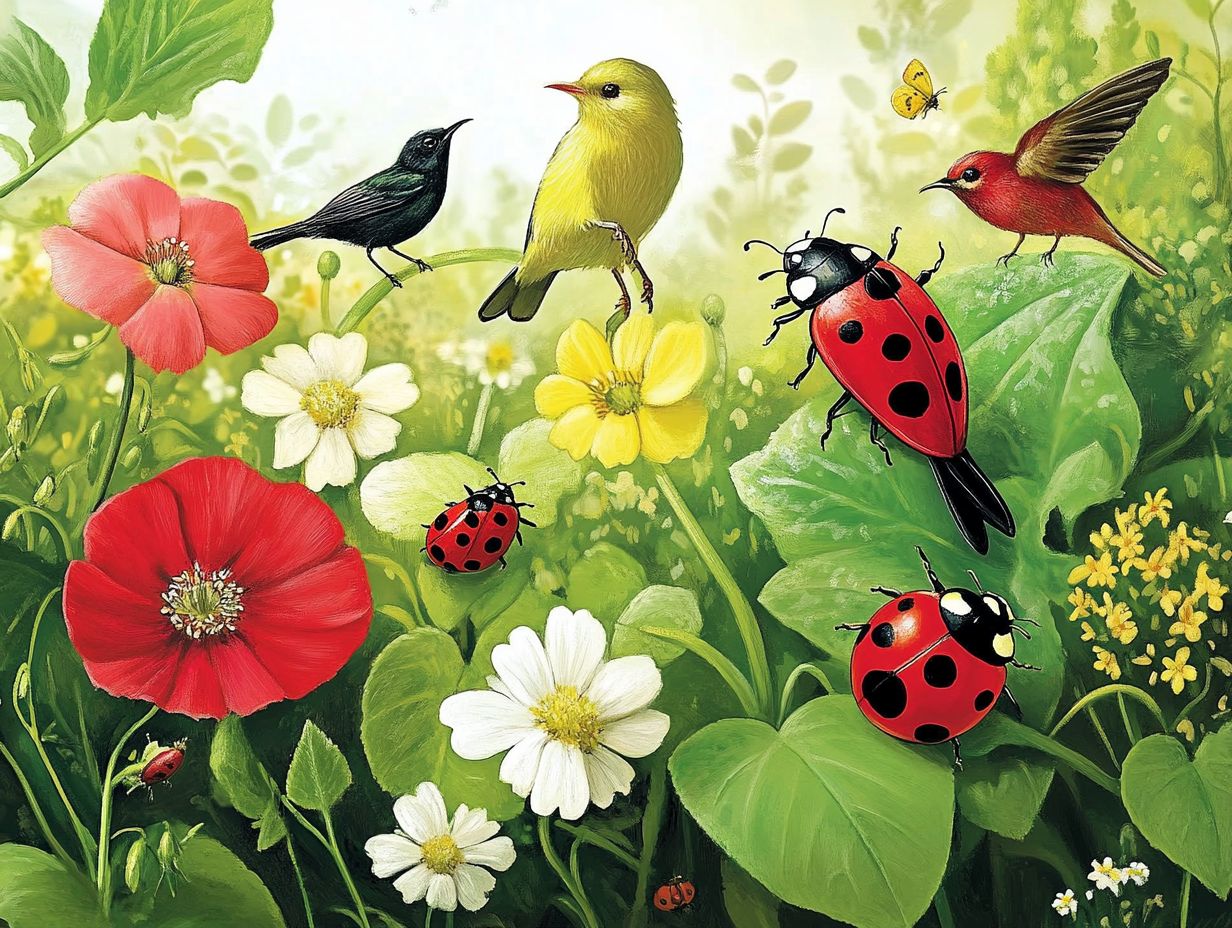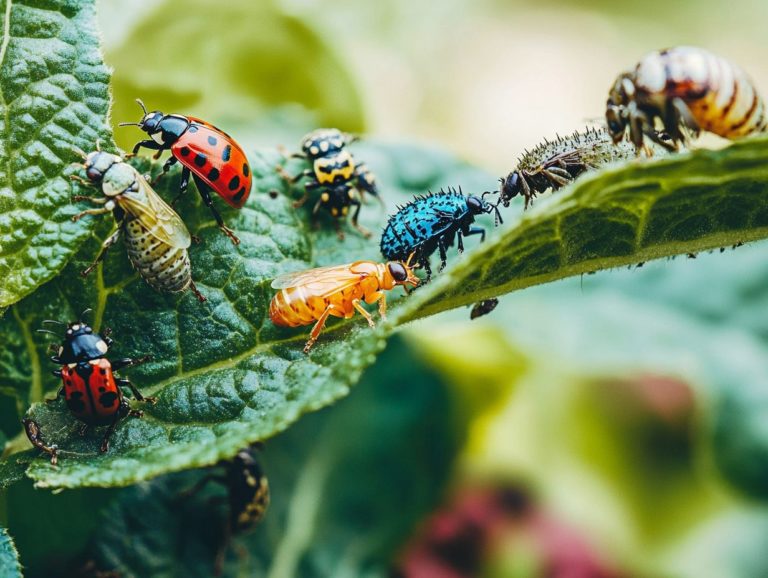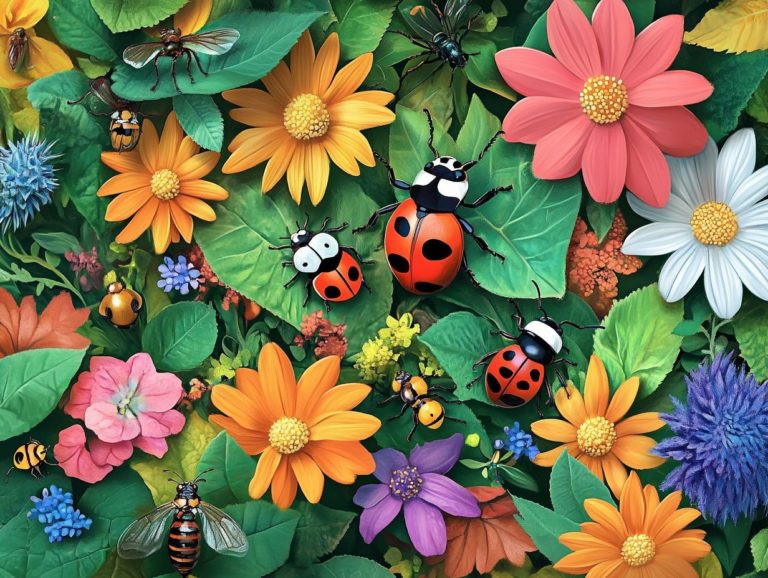Understanding the Benefits of Pest Predators
In the ongoing battle against pests, it’s easy to overlook the crucial role of their natural predators. From aphids to ants, these remarkable creatures not only help keep pest populations in check but also contribute to a healthier ecosystem.
In this article, we explore why effective pest control is essential and how natural predators are your best allies. It highlights the environmental and economic advantages of incorporating these allies into your pest management strategies.
You will find tips on creating a welcoming environment for these beneficial predators, alongside a debunking of common myths surrounding them. Unlock the power of nature’s safeguards to transform your pest control game!
Contents
- Key Takeaways:
- The Importance of Pest Predators
- Types of Pest Predators
- Benefits of Using Pest Predators
- Environmental and Economic Advantages
- How to Attract Pest Predators
- Common Misconceptions About Pest Predators
- Frequently Asked Questions
- What are pest predators and why are they beneficial?
- What are the advantages of using pest predators over chemical pesticides?
- How do pest predators help control pest populations?
- What are some examples of common pest predators?
- Do pest predators only benefit gardens and crops?
- How can I attract pest predators to my garden?
Key Takeaways:

- Pest predators are vital for controlling pest populations and support a healthy ecosystem.
- Natural predators are more effective and sustainable than introducing non-native species for pest control.
- Attracting pest predators through habitat and food sources can save money and reduce reliance on harmful pesticides.
The Importance of Pest Predators
Pest predators serve a pivotal role in natural pest management, expertly managing insect pests by harnessing natural enemies like predatory insects, which eat other pests, and parasitoids, which lay eggs in pests.
These natural agents help maintain pest populations at manageable levels and lessen reliance on chemical control methods, significantly mitigating economic harm to crops.
Grasping the essential functions of these predators is key to crafting sustainable pest management systems that foster ecological balance in the agricultural landscape.
Why Pest Control is Essential
Pest control is vital in agriculture, safeguarding your crops from a variety of pest species that could inflict serious economic harm and cause significant damage.
These infestations can diminish yields and compromise quality, ultimately impacting your livelihood and the stability of the food supply. Implementing effective pest management strategies, such as a combined approach to pest management, allows you to identify pests while reducing reliance on pesticides that can negatively affect the environment.
By embracing sustainable practices, you can boost productivity while minimizing the economic risks linked to pest outbreaks. As pest populations continue to adapt, staying informed about the latest control methods and technologies becomes essential for maintaining resilience in your agricultural endeavors.
Types of Pest Predators
You will find an array of pest predators at your disposal, including natural allies like predatory insects, parasitoids, and pathogens. Each of these plays a vital role in sustaining effective pest control within agricultural environments.
Natural Predators vs. Introduced Species

Natural predators are the native species that coexist harmoniously with pest populations, while introduced species serve as foreign biological control agents designed to bolster your pest management systems.
Understanding this distinction is vital for grasping their roles in maintaining ecological balance. Native predators have co-evolved alongside local pest populations, often fostering more sustainable interactions and enhancing resilience within ecosystems.
In contrast, introduced species may offer immediate relief from pest outbreaks, but they can also disrupt local food webs and outcompete native organisms. You must critically evaluate the effectiveness of these approaches within the context of your specific ecosystem to ensure not just short-term pest control, but also long-term ecological health.
Balancing these factors is crucial for crafting effective pest management strategies that uphold biodiversity.
Benefits of Using Pest Predators
Utilizing pest predators presents a wealth of environmental and economic benefits, positioning them as a crucial element in sophisticated pest management strategies.
Embracing this approach not only enhances ecological balance but also contributes to cost-effective solutions in maintaining your agricultural or gardening endeavors.
Start today! Create a pest-friendly garden and watch your ecosystem thrive!
Environmental and Economic Advantages
The environmental and economic benefits of utilizing pest predators are substantial, offering you the dual advantage of reduced pesticide use and enhanced sustainability in your agricultural practices.
By introducing natural pest predators into your farming ecosystems, you can significantly lessen the negative impacts associated with chemical control methods. This approach enhances pest control agents such as beneficial nematodes and contributes to healthier soil and greater biodiversity. Your crops can flourish without the detrimental effects typically linked to synthetic pesticides.
Act now to embrace biological control methods and boost your farm’s resilience! These natural allies work tirelessly to maintain ecological balance, enhancing your farm’s productivity while promoting sustainable agricultural practices that uphold environmental integrity.
How to Attract Pest Predators
Cultivating a pest-friendly environment is essential for drawing in beneficial organisms and sustaining the population of natural predators within agricultural landscapes. This approach enhances biodiversity and fosters a balanced ecosystem that can effectively manage pest populations naturally.
Creating a Pest-Friendly Environment

Habitat management is essential for cultivating an environment that invites beneficial insects and promotes a harmonious ecological balance.
By implementing targeted practices like enhancing crop diversity, you can create a dynamic landscape that attracts predatory insects such as ladybugs and lacewings, which are important in controlling pest populations. Preserving natural habitats think hedgerows and wildflower strips provides these valuable allies with shelter and resources, ultimately boosting their populations.
Reducing pesticide usage is equally important. It helps sustain the delicate ecosystem balance, allowing vital pollinators and pest predators to flourish. Embracing these sustainable practices will lead to healthier crops and a more resilient agricultural landscape, setting you up for long-term success.
Common Misconceptions About Pest Predators
Misunderstandings surrounding pest predators can significantly impact your pest management approach, leading to ineffective strategies and a skewed perception of their vital role in biological control.
Debunking Myths and Misinformation
Debunking the myths surrounding pest predators begins with a deeper understanding of their true capabilities and the crucial role they play in effective biological control.
Many individuals mistakenly believe that natural enemies, like ladybugs and lacewings, are no match for synthetic pesticides. This leads to an overreliance on chemicals that can have detrimental effects on the environment. This misconception may prevent you from embracing integrated pest management (IPM), a way to manage pests using a mix of natural methods and limited pesticides.
In reality, when you properly utilize pest predators, you enhance crop health and biodiversity, fostering sustainable agricultural practices. Acknowledging the beneficial relationship these predators maintain with pest populations can significantly improve your agricultural methods, promoting a balanced ecosystem and reducing the dependence on harmful chemicals.
Frequently Asked Questions
What are pest predators and why are they beneficial?

Pest predators are animals that naturally prey on pests, such as insects and rodents. They are beneficial because they help control pest populations and reduce the need for chemical pesticides.
What are the advantages of using pest predators over chemical pesticides?
Using pest predators instead of chemical pesticides is a more environmentally friendly option. It reduces the amount of harmful chemicals released into the environment and minimizes the risk of harm to non-target species.
How do pest predators help control pest populations?
Pest predators hunt and feed on pests. They keep pest populations in check and disrupt their life cycle, preventing reproduction and further damage.
What are some examples of common pest predators?
Common pest predators include ladybugs, lacewings, spiders, birds, and bats. These creatures are natural enemies of pests like aphids, caterpillars, and mosquitoes.
Do pest predators only benefit gardens and crops?
Pest predators benefit any environment with pests. They can help in homes, parks, forests, and urban areas.
How can I attract pest predators to my garden?
Create a welcoming habitat to attract pest predators. Provide shelter, water sources, and a variety of plants that attract predatory insects and other beneficial insects.






